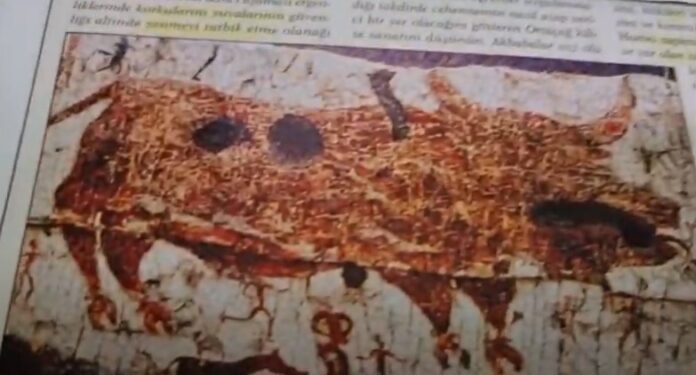2021 Konya – Turkey
Meat and bread, how about ‘meat bread’?
The dough is rolled out as thin phyllo.
Meat is placed on top of it and cooked in the oven.
Food culture in Konya and food culture in Çatalhöyük.
We saw the bakery.
We saw the employees.
There is a good staff here.
These cooks are the masters of Konya.
There are some masters among them.
There are also new learners.
This is how meat and bread were made in Çatalhöyük nine thousand years ago.
It’s a tradition here.
This tradition is a food culture established by the people of Çatalhöyük.
There are many important documents in the archaeological museum.
One: These are statues of fat women.
Two, there are those that are presented as skeletons.
These two pieces of evidence suggest that people at Çatalhöyük were healthy.
They ate meat and bread to be healthy.
This tradition continues in Konya today.
Fat female figures represent healthy women.
A healthy woman gives birth to a healthy baby.
A third important issue: Red paint.
Çatalhöyük people discovered the red dye.
He painted this paint on the walls.
He drew a house plan on the walls.
He developed the art of architecture with Red paint on the Walls.
The art of painting developed with red paint.
The dead were covered with red paint.
The fourth important topic is Taurus…
Ladies and gentlemen…
There are pictures of Taurus on the walls.
There are Bull horns on the walls.
What does this mean?
The bull was a symbol of production and strength.
The boys prepared for the bull hunt with special training.
There are Çatalhöyük documents in Çatalhöyük.
In Turkey, Konya Cumra.
Ladies and gentlemen…
This is Konya Archaeological Museum.
History and Çatalhöyük.
The people of Çatalhöyük founded the first city in the world.
About five thousand people lived together in Çatalhöyük.
There were no streets in this city.
There were no windows or doors in the houses.
Wheat, barley, chickpea and pea production started here.
Sheep, goats and cows were domesticated here.
Here the cult of the Bull was formed.
The Bull Mountains start from here.
It extends to the east to the cities of Kars and Erzurum.
These Mountains are called Taurus Mountains.
Toro, Taurus in Latin means Taurus, bulls.
These mountains are called the Turkish Bull Mountains.
This mountain chain starts close to Konya. The people of Çatalhöyük hunted Bulls in these mountain foothills.
The cult of the bull was formed in Çatalhöyük.
The bull is a powerful animal.
The bull became a symbol of procreation and fertility in Çatalhöyük.
That’s why the name Bull Mountains was given there.
These foothills had obisidian springs.
The people of Çatalhöyük made obsidian knives, arrows and cutting tools.
The obsidian trade started here.
This was prehistoric eight or ten thousand years ago.
There are other Huyuks and tumuli around Konya.
This civilization developed with the civilization of adobe houses.
Turkey is an earthquake zone.
There were volcanoes in prehistoric Turkey. A house made of adobe is not destroyed in earthquakes.
Anatolia, today’s Turkey tells the history of people living in mud brick houses.
Two root languages emerged at Çatalhöyük.
Celtic and Turkish.
Phonetic structure, language, words and sentences based on phonology developed in Çatalhöyük.
He settled in Pre-Turkish Anatolia, around Konya and headed Eastern Anatolia.
Celtic passed from the North to Europe through the Bosphorus Straits to Thrace.
Thus, two root languages were formed.
European languages emerged from Celtic.
This language, which went east from Turkey, formed other Turkish languages.
Turkish has the Epic of Gilgamesh, a Sumerian cuneiform narrative.
The Epic of Gilgamesh tells about the cities of Ur, Uruk, Urfa and other cities starting with Er.
For example, Er, Erzurum, Ermenek.
Er means city in Sumerian.
As a result, Turkish is based on eight vocals and eight voices.
In this sense, Çatalhöyük is in the land where two root languages emerged.
Tekin Sönmez,
09 October 2021
Konya – Turkey






















